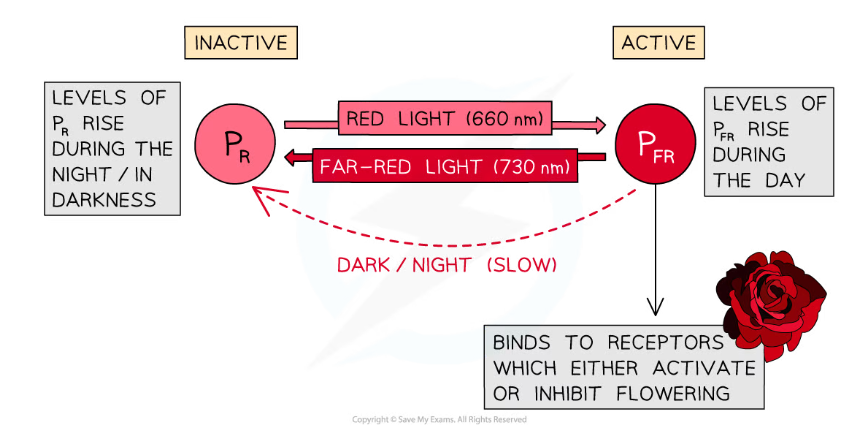- 翰林提供学术活动、国际课程、科研项目一站式留学背景提升服务!
- 400 888 0080
Edexcel A (SNAB) A Level Biology:复习笔记8.1.8 Phytochrome
Phytochrome
- Flowering in plants is controlled by the stimulus of night length
- Nights are shorter during the spring and summer and longer in the autumn and winter
- Some plants flower when nights are short and some flower when nights are long
- When the nights reach a certain length, genes that control flowering may be switched on or off, leading to the activation or inhibition of flowering
- Genes that are switched on are expressed, leading to production of the polypeptides for which they code, while genes that are switched off are not expressed, so the polypeptides for which they code are not produced
- The length of night can be detected by a plant because it determines the quantities of different forms of a pigment called phytochrome in the leaf
Phytochrome
- The phytochrome pigment exists in two forms
- PR is the inactive form of phytochrome, it absorbs light from the red part of the spectrum (wavelength 660 nm)
- PFR is the active form of phytochrome, it absorbs light from the far red part of the spectrum (wavelength 730 nm)
- Absorption of different wavelengths of light causes a reversible conversion between the PR and PFR forms of phytochrome
-
- When PR absorbs red light (660 nm) it is converted into PFR
- When PFR absorbs far red light (730 nm) it is converted back into PR
- In the absence of red light, the unstable PFR gradually converts back into PR
- During the day levels of PFR rise
- Sunlight contains more wavelengths at 660 nm than 730 so the conversion from PR to PFR occurs more rapidly in the daytime than the conversion from PFR to PR
- During the night levels of PR rise
- Red light wavelengths are not available in the darkness and PFR converts slowly back to PR

PR is converted to PFR in a reversible reaction which controls flowering
E.g. long day plants
- Long day plants flower when the nights are short e.g. in summer
- When nights are short, the day length is longer, hence the term 'long day plants'
- In long day plants high levels of the active form of phytochrome activate flowering
- Flowering occurs due to the following process
- Days are long so PR is converted to PFR at a greater rate than PFR is converted to PR
- The active form of phytochrome, PFR, is present at high levels
- High levels of PFR activate flowering
- PFR activates expression of genes that stimulate flowering
- The active gene is transcribed and translated
- The resulting protein causes flowers to be produced rather than stems and leaves
转载自savemyexams

早鸟钜惠!翰林2025暑期班课上线

最新发布
© 2025. All Rights Reserved. 沪ICP备2023009024号-1








